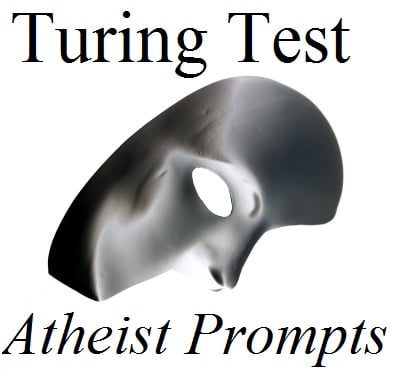
This is the fourth entry in the Atheist round of the 2013 Ideological Turing Test. This year, atheists and Christians responded to questions about sex, death, and literature.
Polyamory
The morality of all relationships can be reduced to three notions: kindness, fairness and consent. When relationships exit morality, they violate these virtues: infidelity disrupts informed consent; abuse epitomizes the violation of kindness; control, by nature, eliminates equity. As such, the morality of any consensual, equal, benevolent union is inherently moral – including the polyamorous.
Sacramental marriage, like all ritual, celebrates valued action. Today, Christian denominations hold wildly varied rules for sacramental marriage, as they should. Doctrine-infused sacraments logically enforce doctrinal requirements — protestant baptism celebrates and requires a confession of faith, and Catholic Last Rites provide absolution and blessing to only dying Catholics. Sacramental recognition of marriages depends on a church’s definition of marriage, its boundaries and requirements.
Historically, the notion of marriage included just two parties. As such, centuries of legal statues were crafted for the betterment of a male-female union. Polyamorous marriages have simply not been considered or afforded for in statutes and case law around custody, inheritance, medical rights, divorce, bigamy, and finances.
In the same vein, some polyamorous marriages may involve multiple parties entering into a single union together, while others would involve simultaneous, separate unions – making informed consent central. Bigamy laws aim to protect unwitting spouses – something extremely difficult to discern and prove without the witnessed signature of the prior spouse in coinciding unions.
Such areas of the law would need to be developed to prevent harm to spousal health and well-being were polyamorous marriages legalized.
Another difficult aspect of legalizing polyamorous unions involves restriction of number of parties. A marriage with 50 partners hardly preserves the selection or effective partnership of marriage, but arbitrarily suggesting a cap opposes the mindset behind the legalization of such unions. Making polyamorous marriage more difficult via additional, detailed prerequisites or laborious dissolution could provide a solution – though hardly one that would feel equal to two-person legal unions.
Historically, many polyamorous marriages have also lowered rights of female parties while magnifying power held by males. While modern polyamory seems to strive for equity (at least in ideal), legal and societal consideration would need to be made to preserve equal rights when involving a lone male with multiple female partners (who naturally dissolve the strength of marital legal benefits through fractioning).
We idealize all forms of marital love, many of us desiring to preserve those ideals – even when they are ones we can’t quite reach personally in iteration. Being beautifully human, we fall short of our own standards, even within unions we’ve self-declared as definitively moral. We have the right to define love and sacrament as we please. The government has the obligation to ensure the safety and interests of those entering unions its sanctions (and their offspring). Until it can do so effectively, it simply shouldn’t.
Euthanasia
When time is exceedingly short and pain runs excruciatingly high, we are not only justified – but compelled – to perform euthanasia. However, forms of euthanasia should be restricted to lack of extraordinary medical intervention and necessary pain management, always complaint with patient wishes and performed under strict regulation.
In terminal cases, the body faces multiple, simultaneous and varying threats. A single, terminal patient may face potential kidney poisoning (considered one of the most peaceful, gradual and painless deaths), internal hemorrhaging and pulmonary edema. In such cases, measures such as dialysis might extend life by days or weeks, only to assure a more distressing death — hardly an act of benevolence. Physicians opting for these “good deaths” should not be opened to criminal charges for denying such care.
Informed consent should be paramount in patient-directed euthanasia. Those wishing to end their own lives should — after undergoing counseling, education, mandatory second opinions and “waiting periods.” Euthanasia should never be imposed or disallowed against the patient’s pre-stated wishes. Suffering is a personal measurement, often misperceived via bias and projection (less than 5% of hospital deaths involve unmanaged pain).
Euthanasia should require hard, measurable standards – the visible shutting down of systems in the body, excruciating, unmanageable pain, small life span (perhaps measured in weeks), or pre-ordered, informed wishes. This would prevent euthanasia from being imposed with negative motivations upon the powerless — mentally ill, infants, elderly, and the uninsured (in actuality, minorities and the poor).
In some cases, medical intervention such as surgery, is the route to least pain (such as cauterizing internal hemorrhaging). Physicians need to work from a primary equation of harm vs. help, not merely the factors of percentage chance of long survival and medical cost. If a patient’s quality of life will vastly improve (e.g., increased consciousness or alleviation of pain) for a notable period, medical intervention should be performed.
Legalized euthanasia would need informed, specific consent that reaches far beyond today’s advanced directives – currently covering lifesaving measures, not situations. Those signing may not imagine the complexity and timing of medical situations – including those where a low percentage of recovery still might mean full recovery. Likewise, a 0% of 5-year survival is drastically different than a 0% chance of 30-day survival; one might have 0% chance at living a year, but 100% chance at 6 months, with a given procedure.
Similarly, current “quality of life” measures ask the patient questions and then calculate such quality. Such assessments can only be made by the patient himself (or those who know what he most cherishes about life) – not by state-imposed equations. To some patients, the ability to hear loved ones and music – even if they cannot speak back – makes life worth living. To others, cognitive ability trumps even the senses. To still others, being bedridden itself would be enough motivation to trade time for escape.
Additionally, the quality of life sometimes includes the business we finish in our lifetimes. Euthanasia could disrupt the last stages of personal development — repaired relationships, confessions of love and crime, and religious conversions in final days.
Euthanasia should remain an option for “good death” – but its legalization doesn’t guarantee it. Only with high standards of regulation and review can legalized euthanasia ensure benevolent – rather than malevolent – rescue from suffering.
Bonus
My faith is like an epic haibun – a hybrid, alternating between the journey recounted in unrestricted prose punctuated by short, bursts of art, memory and epiphany in 17 syllables of haiku.
The haibun divides the books of my life into chapters. I see my life in stories, scenes, exemplified by the haibun’s prose-poems. These scenes are selected and told to record and illuminate some truth, captured or motioned toward in the understated haiku. Those haikus – short, descriptive, vibrant, often praising something – mirror the container I find in ritual I still return to, even as a non-theist, as I attempt to contextualize an expansive world.
How can an atheist hold faith? I manage to. It’s a dedicative faith in the “fruit of the spirit,” “the golden rule,” the occasional miracle, testimonies of transformation, the power of compassion, and the strength of fellowship. It’s a persisting love for the scriptures I can’t unmemorize and people I don’t know but want to help. It’s a wonder in what I can’t explain, and a belief that anything is possible in the presence of belief itself (where every action begins).
Faith acts as a container for all of these beliefs. It’s the structure I learned to hang them on, the metaphor in which I learned to understand. It’s the haiku in the haibun: a small window, a snapshot of deeper concepts and a vast world.
You can vote on whether you think these answers were written by a Christian or an Atheist here. Comments are open to discuss the substance of the post and for speculation about the true beliefs of the author, so please vote before looking at the comments.














